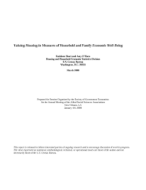
An official website of the United States government
Here’s how you know
Official websites use .gov
A .gov website belongs to an official government organization in the United States.
Secure .gov websites use HTTPS
A lock (
) or https:// means you’ve safely connected to the .gov website. Share sensitive information only on official, secure websites.
-
//
- Census.gov /
- Library /
- Census Working Papers /
- Valuing Housing in Measures of Household & Family Economic Well-Being
Valuing Housing in Measures of Household and Family Economic Well-Being
Valuing Housing in Measures of Household and Family Economic Well-Being
Discussion & Conclusions
This paper has examined the incorporation of housing benefits in some measures of economic well being. The research examined two methods of doing this. One method, currently used in the Census Bureau alternative income definition series, approximates imputed net rental income using a return to home equity approach. The current method includes housing benefits based on 1985 AHS data, and simulates income taxes independently of housing cost imputations. The second method attempts to account for housing financing changes, uses currently estimated housing subsidy values and incorporates housing expenses in that calculation of taxes.
By design, the newer method does a better job of targeting the benefits and costs of housing for certain subgroups of the population, in particular younger households paying high housing costs as interest and property tax expense on owned homes. Results suggested that the current method, which cannot account for housing costs, assigns too much net rental income to younger households. As mortgage financing markets change over time, including additional debt for older homeowners at higher interest rates and loan-to-value ratios for lower income households, a method that takes explicit account of interest payments and debt produces better estimates to assess the ability of households to meet their shelter needs. The new method described here provides an improved method of valuing housing subsidies with some additional methodological problems that will be addressed in future work.
Share
Related Information
Some content on this site is available in several different electronic formats. Some of the files may require a plug-in or additional software to view.
 Yes
Yes
 No
NoComments or suggestions?


Top

